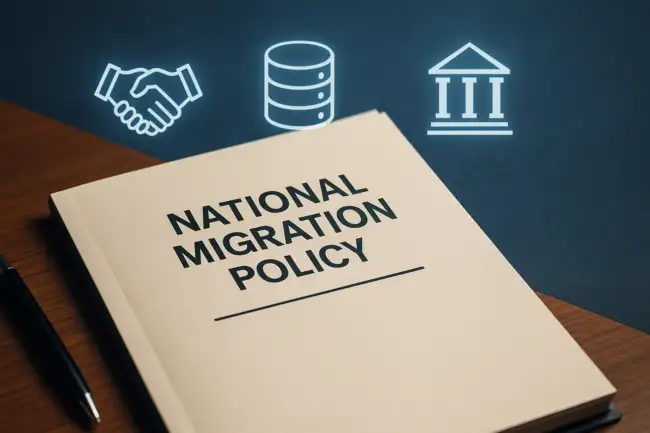Introduction
Migration has always been a part of Zambia’s social and economic fabric. Whether it involves internal movements within provinces or international flows across borders, migration carries significant implications for national development. Yet, despite its impact, Zambia does not have a comprehensive national migration policy to guide how migration is managed, monitored, and leveraged for national growth.
This article makes the case for urgently adopting a national migration policy. It highlights the challenges of policy fragmentation, the lack of inter-agency coordination, and the limitations posed by poor migration data. It further proposes a structured policy framework that can guide Zambia towards a more integrated, evidence-based, and development-focused approach to migration governance.
Why Migration Matters to Zambia
Migration intersects with nearly every sector of development:
- Labour: Migrants fill gaps in the workforce and contribute to both formal and informal economies.
- Education: Internal migration affects school enrolments and resource allocation.
- Health: Migration has implications for disease tracking, vaccination, and service delivery.
- Trade and Investment: Cross-border mobility enables commerce and regional integration.
- Security: Irregular migration, trafficking, and displacement pose governance challenges.
- Climate: Environmental shocks drive internal displacement and rural-to-urban migration.
Managing these intersections without a policy leads to uncoordinated, reactive responses that waste resources and overlook development opportunities.
The Current State of Migration Governance in Zambia
In Zambia, migration responsibilities are spread across multiple ministries and departments:
- Department of Immigration (Ministry of Home Affairs)
- Central Statistical Office
- Ministry of Labour
- Ministry of Foreign Affairs
- Ministry of Community Development
Despite their involvement, there is no overarching framework or strategy to align their roles. This has led to several challenges:
- Institutional Silos
Agencies collect data independently, resulting in duplication, contradiction, or underreporting. - Outdated or Fragmented Legislation
Migration-related laws focus primarily on immigration and do not address emigration, internal migration, or diaspora engagement. - Lack of Data Coordination
There is no central migration data platform. Policymakers rely on outdated census data or fragmented administrative records. - Unfunded Mandates
Initiatives like the Diaspora Policy have stalled due to unclear leadership and insufficient resources. - Reactive Crisis Management
Migration issues such as displacement or trafficking are addressed in emergency mode, rather than through prevention and preparedness.
The Risks of Delay
The absence of a national migration policy creates serious developmental risks:
- Urban congestion due to unplanned rural-to-urban migration
- Loss of human capital through unmonitored emigration
- Weak border security and uncoordinated responses to irregular migration
- Ineffective diaspora engagement due to lack of strategy
- Missed economic opportunities from migration-related trade, investment, and remittances
Zambia cannot afford to ignore migration any longer. Without a clear policy, migration will continue to be viewed as a problem to solve rather than a tool to harness.
What a National Migration Policy Should Address
A well-crafted migration policy should be:
- Inclusive: Cover all forms of migration (internal, cross-border, circular, return, and forced displacement)
- Data-Driven: Built on updated migration statistics and trends
- Human-Rights Based: Prioritize the rights and safety of migrants, especially vulnerable groups
- Development-Oriented: Align migration governance with Zambia’s Vision 2030 and National Development Plans
- Whole-of-Government: Ensure every relevant ministry, local authority, and agency is engaged
- Whole-of-Society: Include academia, civil society, private sector, and migrants themselves in design and monitoring
Key Policy Pillars to Consider
- Migration Data and Research
Develop a National Migration Data Information System. Invest in regular migration profiling, flow monitoring, and administrative data integration. - Interagency Coordination Mechanism
Establish a National Migration Coordination Taskforce with clear mandates and cross-sectoral representation. - Labour Mobility Frameworks
Create bilateral labour agreements, ethical recruitment guidelines, and reintegration support for returnees. - Internal Migration Management
Empower local authorities with data and funding to plan for internal migration flows. Promote balanced urban-rural development. - Diaspora Engagement Strategy
Operationalize the 2019 Diaspora Policy with platforms for registration, remittance management, and investment facilitation. - Irregular Migration and Border Management
Strengthen legal pathways for migration, coordinate border enforcement, and enhance victim protection for trafficking cases. - Migration and Development Nexus
Integrate migration into planning for health, education, housing, and climate resilience.
Implementation Steps
- Policy Drafting and Validation
Launch an inclusive consultation process involving all stakeholders. - Legislative Alignment
Review and harmonize relevant laws such as the Immigration and Deportation Act, Employment Code Act, and Refugees Act. - Capacity Building
Train policymakers, data officers, and service providers on migration-sensitive programming. - Monitoring and Evaluation
Establish performance indicators and a reporting framework to track implementation. - Budgeting and Resource Mobilization
Allocate dedicated funding for policy rollout and partner with donors and regional bodies.
Conclusion
Migration is not a temporary challenge. It is a long-term trend that must be planned for. A national migration policy will help Zambia shift from reactive crisis management to proactive, strategic development.
By building a comprehensive, inclusive, and data-informed framework, Zambia can turn migration into an asset that contributes to job creation, regional integration, innovation, and inclusive growth.
Disclaimer: This article is for informational purposes only and does not constitute legal advice. The views expressed are those of the author and do not necessarily reflect the position of YMS Legal.



